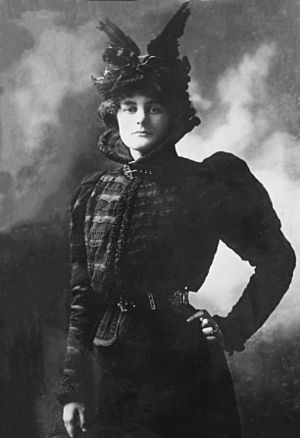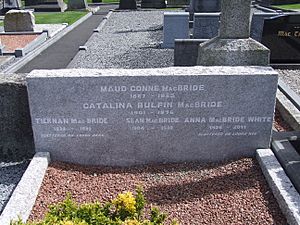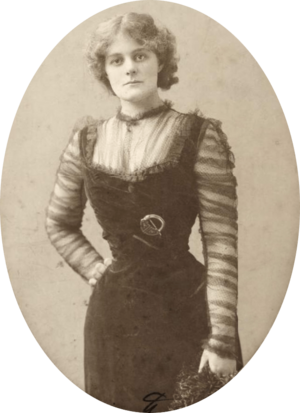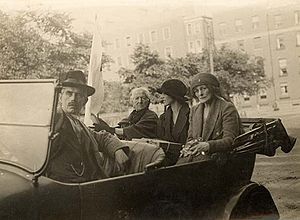Maud Gonne facts for kids
Quick facts for kids
Maud Gonne
|
|
|---|---|
 |
|
| Born |
Edith Maud Gonne
21 December 1866 Tongham, England
|
| Died | 27 April 1953 (aged 86) Clonskeagh, Ireland
|
| Occupation | Activist |
| Spouse(s) | John MacBride |
| Children | Georges Silvère (1890–1891) Iseult Gonne Seán MacBride |
| Parents |
|
Maud Gonne MacBride (21 December 1866 – 27 April 1953) was an important figure in Irish history. She was born in England but became a strong supporter of Irish independence.
Maud was a revolutionary, a suffragist (someone who fought for women's right to vote), and an actress. She was inspired by the struggles of Irish people during the Land Wars. She worked hard for Ireland to have its own government, known as Home Rule. Later, she supported the idea of an independent Irish Republic. Maud Gonne was also known for being a muse to the famous Irish poet W. B. Yeats.
Contents
Maud Gonne's Early Life
Maud Gonne was born in Tongham, England, in 1866. Her full name was Edith Maud Gonne. Her father, Captain Thomas Gonne, was an army officer. Her mother, Edith Frith Gonne, died when Maud was young.
After her mother's death, Maud was sent to a boarding school in France. Her family had roots in County Mayo, Ireland. Maud's father traveled a lot for his army work. He spoke many languages and was at home in different countries.
Starting Her Career
Life in Dublin, London, and Paris
In 1882, Maud moved to Dublin, Ireland, with her father. She stayed with him until he passed away in 1886. After his death, Maud lived in London for a short time. She wanted to become an actress.
Maud inherited a large sum of money, which made her very wealthy. This allowed her to live as she wished. She traveled to Russia in 1888. There, she met a famous newspaper editor, W. T. Stead. He described her as "one of the most beautiful women of the world."
Maud returned to Ireland and started working for the release of Irish political prisoners. These were people jailed for their political beliefs.
Meeting W. B. Yeats
In 1889, Maud met the poet W. B. Yeats for the first time. He quickly fell in love with her. Maud was interested in spiritual and mystical ideas, which Yeats also explored. She even joined a group called the Hermetic Order of the Golden Dawn for a short time.
Maud had a son named Georges in France, but he sadly died when he was very young. Later, she had a daughter named Iseult Gonne.
Founding Inghinidhe na hÉireann
During the 1890s, Maud traveled widely. She campaigned for Irish independence in England, Wales, Scotland, and the United States. In 1896, she started an organization called the "Irish League."
In 1900, Maud helped create Inghinidhe na hÉireann (Daughters of Ireland). This group aimed to fight against English influence in Ireland. They wanted to protect Irish culture and arts.
The group also wanted women to have a strong voice in Irish affairs. Their journal, Bean na hÉireann, stated that women had a right to direct Ireland's future. They believed this was because women were loyal citizens and intelligent people.
Joining Sinn Féin
Maud Gonne believed in peace, but she felt that England was forcing war on Ireland. She thought that to win, they had to fight the enemy.
In 1903, Maud helped form another group called the National Council. This group worked to increase Irish nationalist representation in local government. This meeting is often seen as the start of the Sinn Féin political party.
Maud Gonne as an Actress
In 1897, Maud, along with Yeats, organized protests against Queen Victoria's Diamond Jubilee. This was a celebration of the Queen's long reign.
In 1902, Maud played the main role in Yeats's play Cathleen Ní Houlihan. She played Cathleen, an "old woman of Ireland." This character represented Ireland itself, mourning its "lost" provinces to the British.
Maud often refused marriage proposals from Yeats. She believed his love for her helped his poetry. She also felt he was not radical enough in his Irish nationalism. She converted to Catholicism around this time.
Maud Gonne's Marriage
In 1903, Maud married Major John MacBride in Paris. John MacBride had fought against the British in the Second Boer War. Their son, Seán MacBride, was born the following year.
Maud and John later decided to end their marriage. Maud wanted full custody of their son. A divorce case started in Paris in 1905. While a full divorce was not granted, John MacBride was allowed to visit his son.
John MacBride returned to Ireland and never saw his son again. Maud raised Seán in Paris. John MacBride was executed in 1916 for his role in the Easter Rising. After his death, Maud felt it was safe to return to Ireland permanently.
In 1917, Yeats proposed to Maud again, but she refused. He then proposed to her daughter, Iseult, who also turned him down.
Irish Republican Activism
Maud Gonne was known as the "Irish Joan of Arc" for her strong Irish republican views. She supported Irish Catholic farmers in their fight against landlords. She also spoke out against Irish involvement in the Second Boer War. Her powerful speeches helped create new Irish nationalist groups.
In 1900, Maud wrote an article called "The Famine Queen." It was about a planned visit by Queen Victoria to Ireland. The article was published in US newspapers after being stopped in Ireland.
Maud remained very active in Paris. In 1913, she started a French newspaper called L'Irlande libre. She wanted Cumann na mBan, a women's nationalist organization, to be taken seriously. She worked to get them international recognition. In 1918, she was arrested in Dublin and imprisoned in England for six months.
She worked with the Irish White Cross to help victims of violence. Maud Gonne MacBride was friends with important people, including Charlotte Despard, a famous suffragist. Despard joined Maud on a tour of County Cork, a center of revolutionary activity.
In 1921, Maud opposed the Anglo-Irish Treaty, which created the Irish Free State. She supported the Republican side. She helped set up the White Cross in Ireland to give money to victims. She moved to Dublin in 1922.
During the street battles, Maud led a group called The Women's Peace Committee. They tried to stop the shooting of civilians. In August, she formed the Women's Prisoner's Defence League. This group supported families of prisoners and worked for prisoners' rights. They also published stories about tragic deaths in prison.
Maud was arrested again in November 1922 and taken to Mountjoy Jail. She was released in April 1923. She continued to protest and support hunger strikers.
Other Activism
In the 1930s, Maud Gonne was a key figure in a movement to reform Ireland's financial system. This group became the Irish Social Credit Party. Maud believed that the way goods were distributed was unfair. She argued that there was enough production, but many people still suffered from unemployment and hunger.
She was also involved with the Friends of Soviet Russia organization during the 1930s.
Yeats's Muse

Many of W. B. Yeats's poems were inspired by Maud Gonne. He wrote plays like The Countess Cathleen and Cathleen ni Houlihan for her. His poem "Aedh wishes for the Cloths of Heaven" ends with a reference to her:
I have spread my dreams under your feet; Tread softly because you tread on my dreams.
Yeats often wrote about Maud's beauty in his poetry. He called her "the Rose" and compared her to famous figures like Helen of Troy.
Personal Life and Legacy
Maud Gonne MacBride published her autobiography in 1938. It was called A Servant of the Queen. This title was a clever reference to an old Irish queen she admired, and also a joke about her strong Irish nationalist views.
Her daughter, Iseult Gonne, was educated in France. She also attracted the attention of famous writers. In 1916, Yeats proposed to Iseult, but she refused. In 1920, Iseult married the writer Francis Stuart.
Maud Gonne's son, Seán MacBride, became a very important figure. He was active in the Irish Republican Army (IRA) and in Irish politics. He served as the Irish Foreign Minister. He also helped found Amnesty International and was awarded the Nobel Peace Prize in 1974.
Maud Gonne died in Clonskeagh, Ireland, in 1953, at the age of 86. She is buried in Glasnevin Cemetery in Dublin.
See also
 In Spanish: Maud Gonne para niños
In Spanish: Maud Gonne para niños



